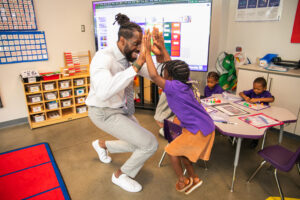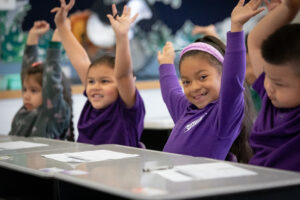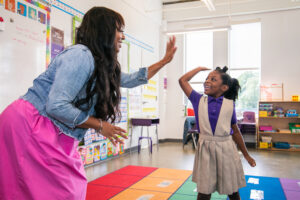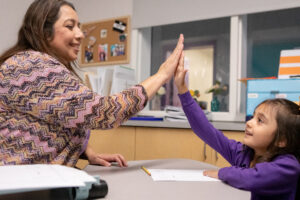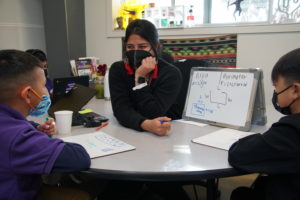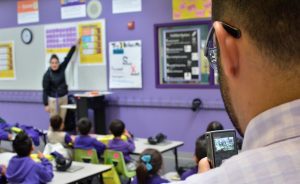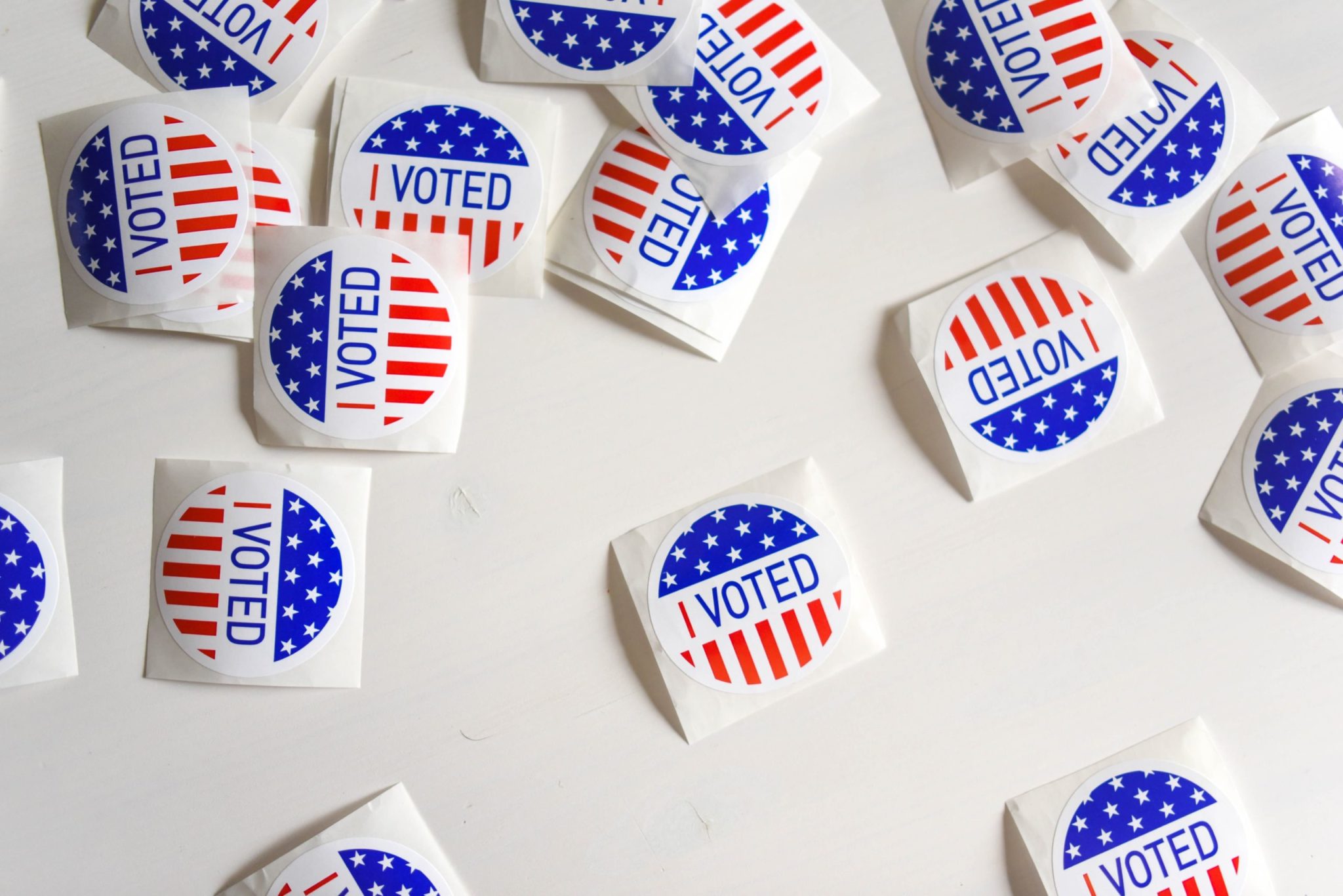
7 Tips to Help Teachers Discuss the Political Climate with Elementary Students
By Emma Volpe, Lead English Language Specialist, Rocketship United Academy
*This post originally appeared on EducationPost.com.
“Don’t talk politics and religion at the dinner table.” I presume I’m not the only one who was brought up under this unspoken rule. With a politically-neutral immigrant father and a politically-silent mother, this taboo ‘p’ word was simply not brought up in our home. I remember the first election I was of-age to vote. I woke up early with my college housemates, drove outside of the university bubble, and cast our votes. I felt so proud but own that I had little to no idea what I was doing. By the time I reached college and the rise of social media was in full force I was flooded by what I consumed from peers or stumbled upon online by my trusted sources at the time (which were Buzzfeed and the Huffington Post).
It really hasn’t been until the last four years that I’ve tried to tackle the ‘p’ word (politics) on a personal level. Especially now in such a polarizing time, I’ve struggled to internalize my own beliefs in a calm and rational manner. Part of me still is pulled by the “don’t talk” notion of the Boomer adults who raised me while the other side is pulled by the vocal, brassy Generation Zs I see online. It’s an odd time to navigate talking ‘politics’ – particularly adding the layer of being a teacher to it.
So how do we equip the next generation to find their voice while also teaching them the value of listening with intention? How do we commission them to develop their own ideas while also being open to an ongoing empathetic dialogue?
This 2020 Election season has been an incredibly interesting time as my school has been predominantly online. There’s no playbook on how to answer students’ hard questions or how to educate them about what is happening in the world without infringing on boundaries. At the end of day, students are aware that something about this season is different than the norm. They default to observing the adults in their lives, so how can we ensure that we are modeling healthy but authentic behavior for them? How do we support the next generation so perhaps they find a way to use their voice with the utmost empathy in order to find a balance between silence and stubbornness? After asking myself many of these questions, reading, listening, and reflecting I believe I’ve collected a sense of personal pragmatisms for how to speak with students about ‘politics’ in a way that focuses on their social-emotional development.
1. Set objectives and norms.
As a best practice in teaching, I’ve been taught to always start with the “why.” Why are we learning or talking about this? What is the ultimate take away you want students to grasp? Then set norms. I’ve found success in writing them out and then giving students a space to discuss and agree upon them. This sets up the conversation to be more successful since it puts the class on the same track.
2. Build community – bring in outside speakers.
A silver lining in this time is the number of people who are now working from home. This means it might actually be more convenient for people to take time to join a Zoom or online call. Take advantage of this exciting opportunity to bring in new and diverse voices to your classroom!
3. Answer their questions.
Students have a keen radar on genuineness. They can read their teachers’ mannerisms and see right through us if we are acting out of our norm. So when students ask questions, yes even difficult ones or ones we may not know the best answer to give, they’ll notice if we dismiss it. That can send a signal to them even if it’s unintentional or subconscious. If it’s a question that may be best answered privately then ask the student to hang back to have that one on one. It’s also okay to not know an answer and share that response. Again, they read our cues so encourage them to ask questions even if they’re hard to answer. It probably means it’s a really good question!
4. Explain both sides.
A best practice in rhetoric or debate is to be ready for counter-arguments. That being said, it’s in a student’s best interest to receive perspective from both sides of a discussion – again, even when it’s hard or contrasting to your own beliefs. It’s vital to emphasize that both sides don’t always hold equal weight. It’s empathetic to listen but doesn’t mean you have to change or accept a countering opinion. Everyone can have an opinion without everyone being right.
5. Teach about credibility.
As stated in the beginning, my trusted sources during college were Buzzfeed and The Huffington Post. Now in full transparency, I still follow both of these sites but with the caveat that I recognize that I need other sources for full validity. Before going into education, my undergraduate studies were all about the societal relationship with the media. It’s complicated and tense to say the least. We rely on news and media outlets to provide us with vital information. There’s a lot of trust involved. We are all media consumers, children included, so it’s a great time for them to practice cognition around what makes a credible source and how to navigate different sources.
6. Focus on making memories.
When we look back at our own schooling experiences there are certain memories that jump out. I still remember making puppets and researching Robert Dinwiddie (a not very famous or important figure during Revolutionary War times) because our teacher made it the biggest deal. The day we presented those puppets made of orange juice cartons made me feel like a celebrity. So focus on how to create memories and experiences that students will look back on as adults and remember.
One way to do this is by hosting grade-wide elections where students run for class president. I decided to do this in tandem with the January inauguration to help students better understand the election process and see the importance of civic engagement first hand.
7. Context > Content
“I’ve learned that people will forget what you said, people will forget what you did, but people will never forget how you made them feel” – Maya Angelou
At the end of the day, students will likely not remember every statistic, fact, piece of news, policy, or person you teach them. What they will remember is the tone of the space and the level of empathy their teacher and peers used. The context of the conversation is vital. Setting up a safe space for dialogue (using an objective and norms) allows students to engage to a degree in which they feel comfortable. If they have positive experiences with the ‘p’ word, the hope is that they hold onto these tools as they get older and have full autonomy in conversations.
This school year has been unlike any other as we all traverse uncharted waters. There’s no one right way to go about it. To me, it’s a tremendously rich opportunity to trust students and create a space for them to process and ask questions. If we equip them with tools to talk about issues that may be categorized as “not having a place at the dinner table,” then we use this time to build their voices and empathy simultaneously. There’s a chance to shift the norms and narrative where students can rewrite their generation. They will do that out of their own resilience, either way, so let’s empower them with the social-emotional tools to be the most effective, empathetic, and engaging generation yet!
Published on January 25, 2020
Read more stories about: Uncategorized.
In the Classroom
3 Ways to Build Strong Parent-Teacher Connections
By Jeremiah Davis & Mrs. Aqeel, Rocketship Dream Community Prep | May 15, 2025
Ready to level up your relationships with your families this school year? Listen in for tips from an experienced teacher known for building strong bonds with parents!
Read more ⟩How to Foster a Growth Mindset in the Classroom
| April 10, 2025
Learn how to cultivate reflection, embrace challenges, and promote perseverance in yourself and in your students.
Read more ⟩How to Improve School Culture
Jeremiah Davis, Paraprofessional, Rocketship Dream Community Prep | March 3, 2025
Ready to ramp up moral at your school? Weave these nine celebrations into your school year!
Read more ⟩How Coaching in Schools Improves Outcomes
Rockesthip Public Schools | Feb 4, 2025
Learn how live coaching and weekly feedback sessions can help your teachers feel more supported year round!
Read more ⟩Parent Conference Tips for First Year Teachers
Jeremiah Davis, Paraprofessional, Rocketship Dream Community Prep | January 6, 2025
Looking for top parent conference tips? Prepare with advice from our educators.
Read more ⟩First Year Teacher? Here are Five Mistakes to Avoid.
Jeremiah Davis, Paraprofessional, Rocketship Dream Community Prep | November 1, 2024
See what mistakes most first year teachers make and how you can get ahead this school year with some simple tips from a fellow educator.
Read more ⟩3 Classroom Systems New Teachers Swear By
Rocketship Public Schools | Sept. 30, 2024
As a first year teacher, establishing a smooth and productive classroom environment can feel a tad overwhelming. Thankfully, these simple strategies can go a long way.
Read more ⟩How Co-Teacher Collaboration Can Benefit Your Classroom
Featuring Alejandra Chavez, Education Specialist at Rocketship Mosaic Elementary | June 10, 2024
Hear from Ms. Aly about how a small team of educators can make a big difference in student outcomes through thoughtful planning, focused collaboration, and personalized accommodations. Ms. Aly was one of our highest-performing educators in California for the 23-24 school year.
Read more ⟩Supporting Parents of Multilingual Students in Family/Teacher Conferences
Emma Volpe, Rocketship United Academy | June 1, 2022
Get thoughtful insight on how to create a more inclusive family-teacher conference environment.
Read more ⟩5 Ways to Strengthen Relationships in the Classroom
James Cross, Assistant Principal, Rocketship Nashville Northeast Elementary | February 20, 2022
A new age of education calls for a new level of connection. Here are some key tips to strengthen relationships in your classroom this school year.
Read more ⟩5 Ways School Leaders Can Coach and Support Teachers
Eesir Kaur, Director of Professional Development | October 15, 2020
Are you a school leader looking to coach your teachers more effectively? Here's what works for us.
Read more ⟩


